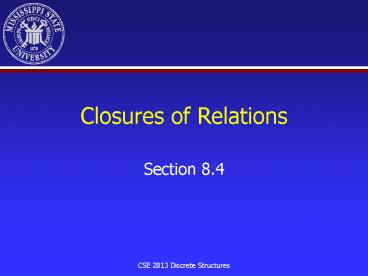Closures of Relations - PowerPoint PPT Presentation
1 / 9
Title:
Closures of Relations
Description:
R is antisymmetric if whenever (a,b) R and (b,a) R, then a = b, where a,b ... R is transitive if whenever (a,b) R and (b,c) R, then (a,c) R, where a,b,c ... – PowerPoint PPT presentation
Number of Views:50
Avg rating:3.0/5.0
Title: Closures of Relations
1
Closures of Relations
- Section 8.4
2
Recap Properties of Relations
- Let R be a relation on set A.
- R is reflexive if (a,a)?R for every element a?A.
- R is symmetric if (b,a)?R whenever (a,b)?R, where
a,b?A.
3
Recap Properties of Relations
- R is antisymmetric if whenever (a,b)?R and
(b,a)?R, then a b, where a,b?A. - Symmetric and antisymmetric are NOT exactly
opposites - A relation can have both of these properties
- Or may lack both of them
- R is transitive if whenever (a,b)?R and (b,c)?R,
then (a,c)?R, where a,b,c?A.
4
Definition of Closure
- The closure of a relation R with respect to
property P is the relation obtained by adding the
minimum number of ordered pairs to R to obtain
property P. - Properties reflexive, symmetric, and transitive
5
Example Reflexive closure
- A1,2,3
- R(1,1),(1,2),(2,1),(3,2)
- Is R reflexive?? Why?
- What pairs do we need to make it reflexive?
- (2,2), (3,3)
- Reflexive closure of R (1,1),(1,2),(2,1),(3,2)
? (2,2),(3,3) is reflexive.
6
Reflexive Closure
- In terms of the digraph representation
- Add loops to all vertices
- In terms of the 0-1 matrix representation
- Put 1s on the diagonal
7
Example Symmetric closure
- A1,2,3
- R (1,1),(1,2),(2,2),(2,3),(3,1),(3,2)
- Is R symmetric?
- What pairs do we need to make it symmetric? (2,1)
and (1,3) - Symmetric closure of R (1,1),(1,2),(2,2),(2,3),
(3,1),(3,2) ? (2,1),(1,3)
8
Symmetric Closure
- Can be constructed by taking the union of a
relation with its inverse. (See Example 2, pg.
497) - In terms of the digraph representation
- Add arcs in the opposite direction
- In terms of the 0-1 matrix representation
- Add 1s to the pairs across the diagonals that
differ in value
0 0 1 0 0 1 1 1 0
9
Transitive Closure
- In terms of the digraph representation
- If there is a path from a to b, add an arc from a
to b (can be complicated) - A path from a to b in the digraph G is a sequence
of one or more edges starting at a and ending at
b.































